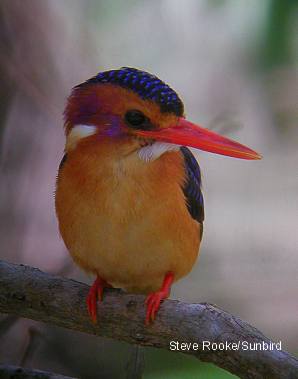|
| 질의: Black back | 결과: 961번째/1142 | |
African Pygmy-kingfisher (Ispidina picta) - Wiki
| 제목: | African Pygmy-kingfisher (Ispidina picta) - Wiki
| |

| 해상도: 298x379
파일크기: 12469 Bytes
등록시간: 2007:11:21 16:05:05
|
African Pygmy-Kingfisher
From Wikipedia, the free encyclopedia
Order: Coraciiformes
Family: Alcedinidae
Synonyms: Ceyx pictus
[Photo] African Pygmy-kingfisher (Ispidina picta). Photo by by Steve Rooke at Sunbird.
The African Pygmy-Kingfisher (Ispidina picta) is a small insectivorous kingfisher found in the Afrotropics, mostly in woodland habitats. Some texts refer to this species as Ceyx pictus.
Size
The African Pygmy-Kingfisher is approximately 12-13 cm in length.
Identification
A very small kingfisher with rufous underparts and a blue back extending down to the tail. The dark blue crown of the adult separates it from the African Dwarf-Kingfisher. The smaller size and violet wash on the ear coverts distinguish it from the similar Malachite Kingfisher.
The natalensis subspecies occurring in the south of the range has paler underparts and a blue spot above the white ear patch. Juveniles have less extensive violet on their ear coverts and a black rather than orange bill. the pygmy kigfisher is a early habitated type of bird that loves winter
Habits
Usually found singly or in pairs. Secretive and unobtrusive.
Habitat
Found in woodland, savanna and coastal forest. Being insectivorous, it is not bound to water.
Status and distribution
The African Pygmy-Kingfisher is distributed widely in Africa south of the Sahara, where it is a common resident and intra-African migrant. It is absent from much of the horn of Africa, and also the drier western regions of Southern Africa.
Call
A high-pitched insect-like "tsip-tsip" given in flight.
http://en.wikipedia.org/wiki/African_Pygmy-Kingfisher
| The text in this page is based on the copyrighted Wikipedia article shown in above URL. It is used under the GNU Free Documentation License. You may redistribute it, verbatim or modified, providing that you comply with the terms of the GFDL. |
|
^o^
동물그림창고 똑똑전화 누리집
^o^
|
|